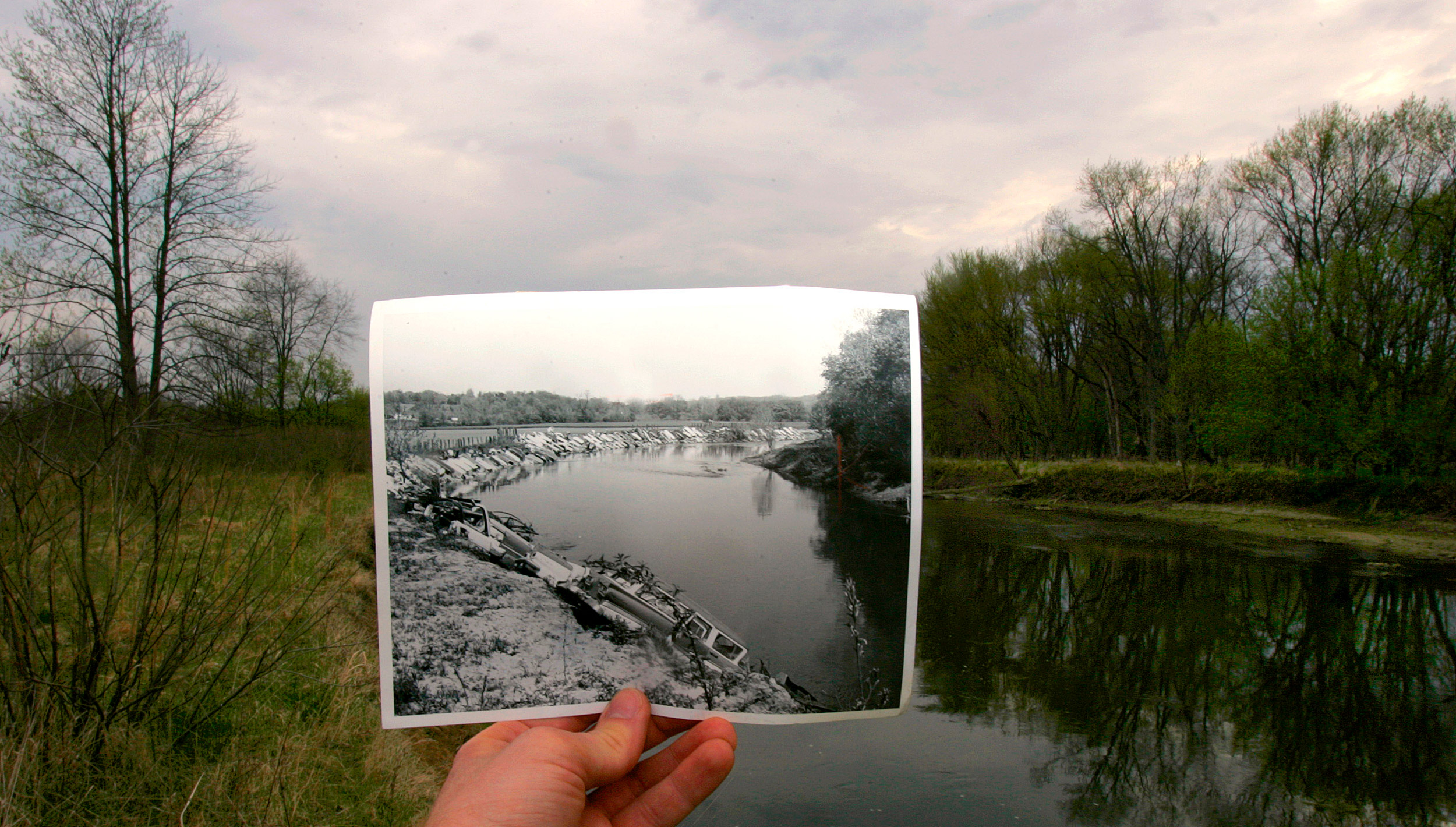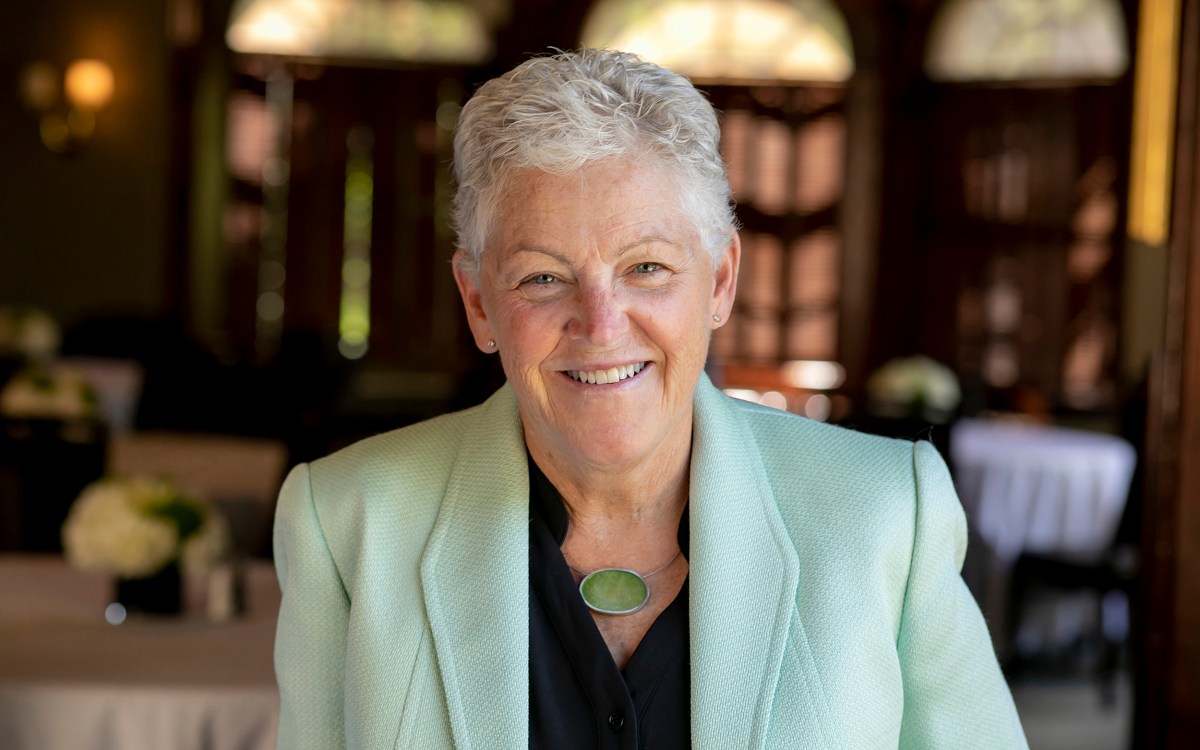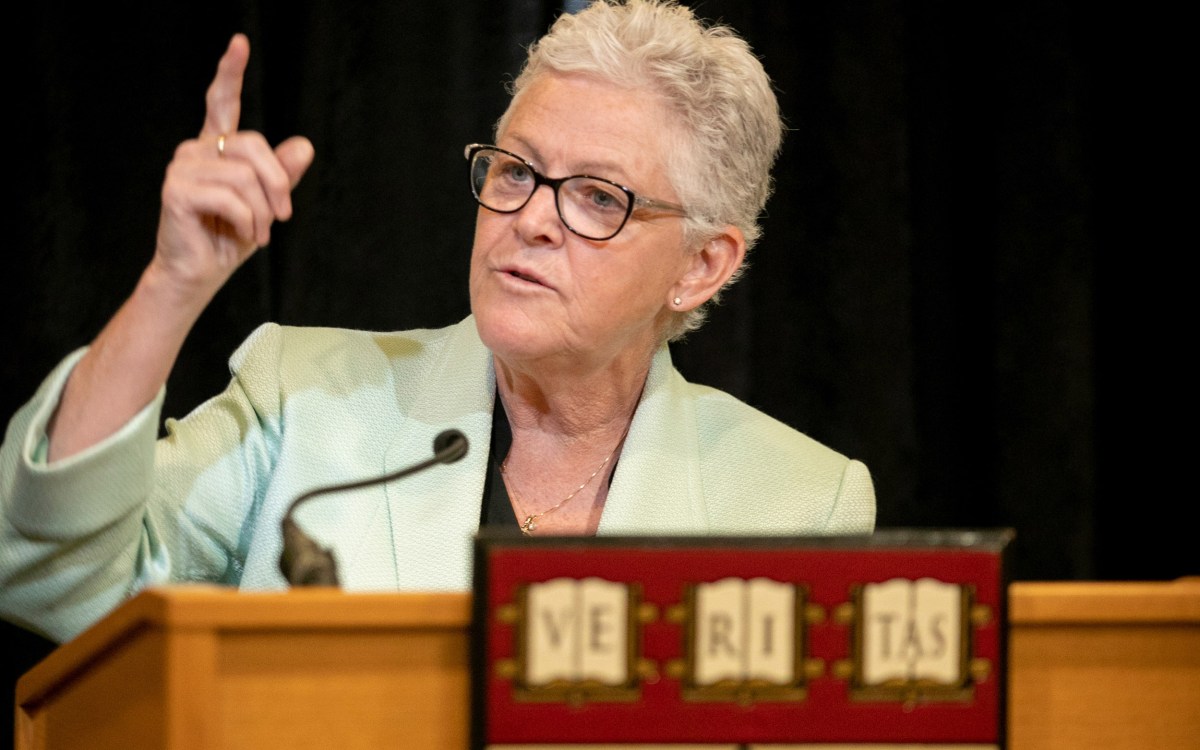
A 1967 photograph, showing cars used as rip-rap along the Cuyahoga River to protect it from erosion, is held in front of its banks decades later.
AP file photo
Sparking a national debate
Former EPA chief Gina McCarthy reflects on the Cuyahoga River cleanup as a symbol for the nation’s progress on clean water
Fifty years ago, Ohio’s Cuyahoga River was so polluted that it caught fire, becoming a powerful symbol for a U.S. public increasingly concerned about the environmental damage around them.
This year, the state of Ohio deemed the river clean enough that its fish are safe to eat.
That remarkable turnaround is part of a broader cleanup of the nation’s waters, air, and land that resulted from a suite of laws passed in the early 1970s in response to public abhorrence at episodes like the June 1969 fire, an abhorrence that found expression on April 22, 1970, the first Earth Day.
Former Environmental Protection Agency administrator Gina McCarthy, professor of the practice of public health at the Harvard T.H. Chan School of Public Health and director of the School’s Center for Climate, Health, and the Global Environment, spoke to the Gazette about the Cuyahoga fire and progress in the decades since. She said the transformation of what was once one of America’s most polluted rivers is an example of the good things that can happen when we stop harming nature and start letting it heal.
Q&A
Gina McCarthy
GAZETTE: Fifty years ago on June 22 the Cuyahoga River caught fire and became a symbol of the nation’s polluted waterways. Were you aware of it at the time and do you recollect what you thought about it?
McCARTHY: I was an early teenager at that point. I remember it happening, yes, but it had no big impression on my life. Lord knows what did then.
GAZETTE: Do you have a sense of what its legacy has been? I’ve read that it was a big part of not just the broader environmental impetus of the ’70s but also the creation of the agency you led, the EPA.
McCARTHY: I do think it had a big impact. People relate to something visual, a visible sign. And this was a clear visual sign that something was terribly wrong.
When water burns, it’s just not normal. There’s no excuse for it and I think for that reason it had a big impact. It generated a lot of local momentum. Nobody waited around for the federal government to act. Cleveland and other [cities and towns] took action.
It showed that we needed to have a national debate, but also that people could take action on their own before that national debate. That, to me, is a really big signal and what turned the corner [on environmental protection]: People everywhere started to engage.
GAZETTE: The river recently passed a milestone, with the state of Ohio declaring its fish safe to eat. What does that say about the potential for environmental cleanup programs to make progress?
McCARTHY: It’s really about resilience, and it’s clearly quite remarkable. We underestimate it every time. We underestimate our ability to change, and when we stop polluting and damaging these resources, we underestimate their incredible resilience. Life finds a way.
So it’s heartening to those of us working hard to avoid the destruction of nature and the harm to people that pollution poses everywhere, that you can not only stop the problem from getting worse, but you can also actually return to a state of normalcy. That provides hope for the future and I think we can all use a little bit of that.
“Today, many of our environmental challenges are not visible. … So while the Cuyahoga was a great visible sign, we have to make sure that we use science to create visibility now.”
GAZETTE: Would you eat Cuyahoga River fish?
McCARTHY: It depends on how you cooked it. But yes, of course I would. I have great faith in the people who have looked at these issues.
GAZETTE: How much should we consider the Cuyahoga’s recovery a symbol of the nation’s larger progress on clean water versus an isolated instance where we did the right thing?
McCARTHY: The Cuyahoga was central to a movement that created an expectation that when we see something wrong, we act on it.
Today, many of our environmental challenges are not visible. They’re longer term, yet still very real. So while the Cuyahoga was a great visible sign, we have to make sure that we use science to create visibility now, with real information and real data. Everything isn’t great just because you can’t see the threats that you’re under.
GAZETTE: Are you talking about climate change, among other things?
McCARTHY: Climate change and many other things — toxic chemicals, synthetic chemicals that we use in products that end up in our water.
The epiphany that we had back during the first Earth Day doesn’t mean that you could fix it then and not continue the investment. We need continued diligence in terms of the cleanliness of the water we drink.
We need to keep rivers and streams flowing and recognize that we have to reinvest in some of the technologies that brought us to where we are today. An old wastewater treatment facility may have been great to stop pollution on the Cuyahoga River, but it’s not going to be sufficient to deal with the chemicals today.
GAZETTE: You mentioned keeping the waters flowing. Are you talking about dam removal, that kind of thing?
McCARTHY: I’m talking about the challenges of climate change. When the Colorado River no longer reaches the ocean, someone should be scratching their head and asking, “How come?”
We keep our water clean by making sure we don’t put so much pollution in there that it damages natural resources or our health. But determining how much is safe is based on flow, isn’t it? Fluctuations in stream and river flow during periods of drought and flood put a monkey wrench in how we protect those waters. We have to think of new ways of recognizing the changing climate and what that means to rivers and streams.
And it’s not just climate; it’s different growth patterns, it’s increased populations and what that means for stress on natural resources, so — and I don’t want to sound negative, I just want to be a realist — the first Earth Day was great. It gave huge momentum [to environmental programs]. But we need a momentum boost again to reengage with the work that is needed to fix the environment, according to today’s standards and today’s circumstances.
GAZETTE: Is there a pollutant that you think is relatively unknown today that will be a household word in 10 or 20 years, like DDT, mercury, or PCBs have been in the past?
McCARTHY: There are some chemicals prominent in the news today, PFOS and PFOAs [used to treat apparel and carpeting, in fire retardants and food can linings], that are showing up in wells and aquifers across the country.
It’s a challenge that will go on for quite some time. It provides a wake-up call that we need to look closely at chemicals before they enter commerce.
Pharmaceuticals are going to be a big deal. The penicillin used in agriculture today is ending up in our food system, that’s creating [drug resistance]. This is a gigantic and growing problem in public health. We see pharmaceuticals in our rivers and streams and our drinking water.
GAZETTE: The current administration is seeking to weaken environmental regulation in a variety of ways. How worrisome is that to you? Is this unusual or part of a broader regulation/deregulation pendulum swing that’s gone on for some time?
McCARTHY: I think it’s very unique. Federal rules are hard to do and rightly so, but they protect people whose right to health and happiness is being harmed when they have no other means of minimizing the damage.
Passing a federal rule takes a lot of scientific analysis, a lot of examining of options and costs. It takes building a public constituency that recognizes the problem and engages in a way that is transparent. The federal government seeks comment and criticism and new ideas.
But what you’re seeing now is that rules that were done consistent with legal requirements, with the authority of the agencies involved, with what the science tells us is important in terms of risk, and after considering reasonable and cost-effective options — all of the rules under the prior administration — are effectively being reconsidered or attempted to be rolled back.
This is for reasons that have nothing to do with whether they were done right or whether there was a problem that needed to be fixed. This is a very, very unusual circumstance.
Generally, when you work that hard to get a federal rule, you’re sending a signal to industry or consumers about what the federal government thinks. And that steers investment by and direction of regulated utilities to try to address traditional pollutants like mercury [and] ozone contamination. Rules to increase automobile fuel efficiency and reduce greenhouse gas emissions sent a signal about what the cars of the future ought to be and how they should plan for that, which sometimes has a 10-year horizon.
I think we’re in a very unusual and dangerous time. If rules are done on the basis of law and science and transparency and public engagement, and when there’s a change in administration we just decide that all of that was wrong regardless of the substance, then we’re in a hell of a pickle in terms of sending a signal that industry can respond to.
GAZETTE: So industry may just wait for the administration to change?
McCARTHY: EPA’s Mercury and Air Toxics Standards requires significant investment by industry to reduce mercury being emitted from utilities and keep it from getting into our food supply. It poses a significant threat to pregnant women and young kids because it is a neurotoxin.
EPA sent a [regulatory] signal and the cost was large, but the benefits were significantly larger in terms of protecting our kids. We saw the mercury levels go down and fish that are cleaner.
It’s already been complied with and huge investments made, so the industry is saying, “Don’t touch this or else you’re giving us all these stranded assets.” It made no difference to this administration; they’re still trying to take away the rule that gave the EPA the responsibility and authority to regulate mercury. So the decision’s going to be that we no longer need to regulate mercury from these utilities, which is exactly the wrong signal.
So if industry has learned that EPA can go through the process and have that final rule made, and the next administration can come in, decide they don’t like it, and get rid of it, maybe the next time, industry actually won’t put the equipment on. Maybe instead of buying a $100 million scrubber, they’re going to put $50 million to an election. What can we do?
GAZETTE: It’s a good time to be an environmental lawyer.
McCARTHY: I feel pretty confident that the courts are going to stop these decisions because the current EPA isn’t showing fundamental flaws in the final rule and that’s what you need in order to change them.
But it sends a terrible signal to the outside world. And it poses a real challenge to our system of governing, which should be giving people comfort that their health will be protected from pollution.
This interview was lightly edited for length and clarity.







